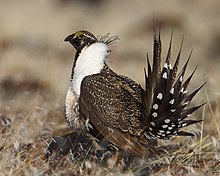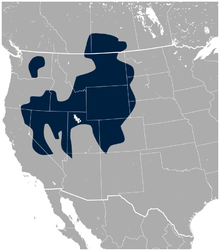| Greater sage-grouse | |
|---|---|

| |
| Male in USA | |
| Scientific classification | |
| Domain: | Eukaryota |
| Kingdom: | Animalia |
| Phylum: | Chordata |
| Class: | Aves |
| Order: | Galliformes |
| Family: | Phasianidae |
| Genus: | Centrocercus |
| Species: | C. urophasianus
|
| Binomial name | |
| Centrocercus urophasianus (Bonaparte, 1827)
| |
| Subspecies | |
| |

| |
| Sage grouse range[3] | |
The greater sage-grouse (Centrocercus urophasianus), also known as the sagehen, is the largest grouse in North America. Its range is sagebrush country in the western United States and southern Alberta and Saskatchewan, Canada. It was known as simply the sage grouse until the Gunnison sage-grouse was recognized as a separate species in 2000.[4] The Mono Basin population of sage grouse may also be distinct.
The greater sage-grouse is a permanent resident in its breeding grounds but may move short distances to lower elevations during winter. It makes use of a complex lek system in mating and nests on the ground under sagebrush or grass patches. It forages on the ground, mainly eating sagebrush but also other plants and insects. Greater sage-grouse do not have a muscular crop and are not able to digest hard seeds like other grouse.
The species is in decline across its range due to habitat loss, and has been recognized as threatened or near threatened by several national and international organizations.
- ^ BirdLife International (2016). "Centrocercus urophasianus". IUCN Red List of Threatened Species. 2016: e.T22679503A92816586. doi:10.2305/IUCN.UK.2016-3.RLTS.T22679503A92816586.en. Retrieved 12 November 2021.
- ^ NatureServe (3 February 2023). "Centrocercus urophasianus". NatureServe Network Biodiversity Location Data accessed through NatureServe Explorer. Arlington, Virginia: NatureServe. Retrieved 4 February 2023.
- ^ BirdLife International and NatureServe (2014) Bird Species Distribution Maps of the World. 2012. Centrocercus urophasianus. In: IUCN 2014. The IUCN Red List of Threatened Species. Version 2014.3. http://www.iucnredlist.org Archived 2014-06-27 at the Wayback Machine. Downloaded on 15 March 2015.
- ^ Young, Jessica R.; Braun, Clait E.; Oyler-McCance, Sara J.; Hupp Jerry W.; Quinn, Tom W. (2000). "A new species of sage-grouse (Phasianidae: Centrocercus) from southwestern Colorado". Wilson Bulletin. 112 (4): 445–453. doi:10.1676/0043-5643(2000)112[0445:ANSOSG]2.0.CO;2. S2CID 20131406.

